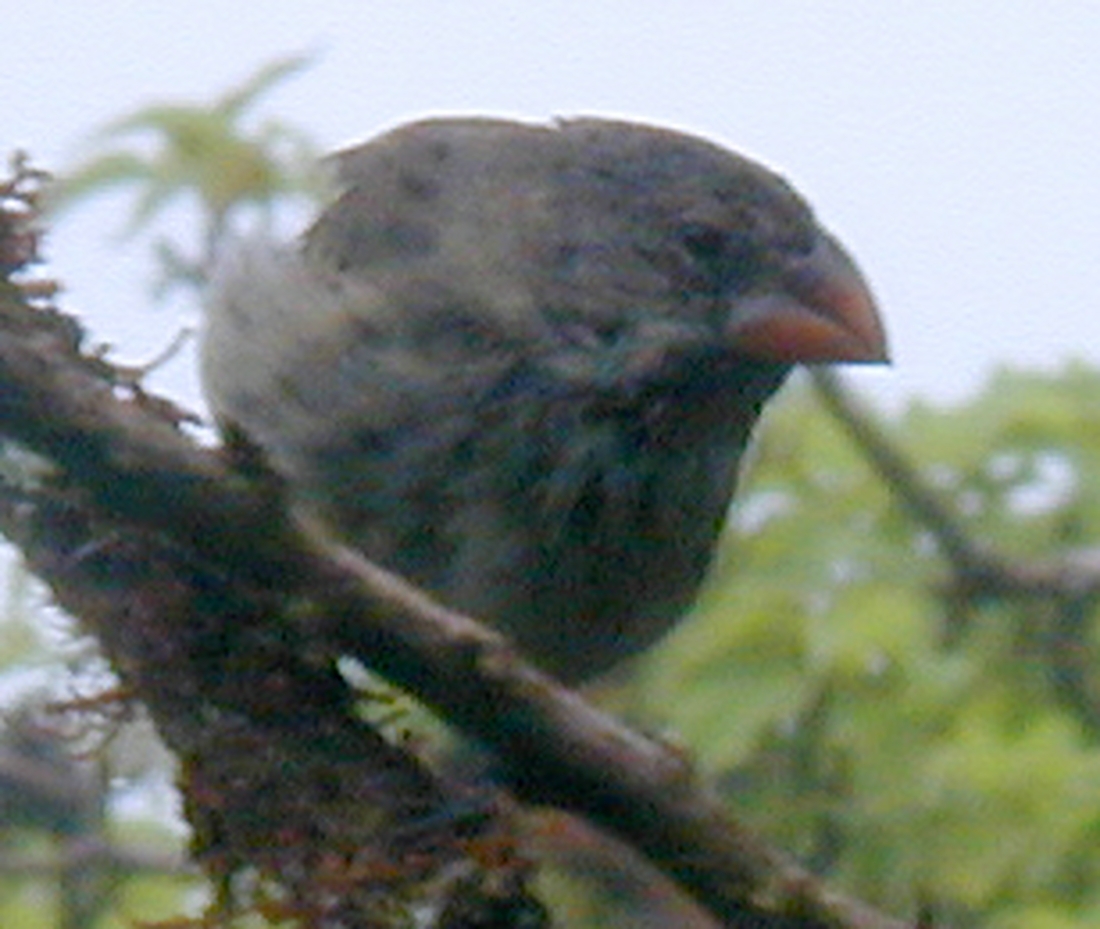Galapagos Species Database
The Galapagos Species Database shares the information about the species from our Natural History Collections.
Camarhynchus psittacula
Pinzón de Árbol Grande, Pinzón arboreo grande, Large Tree Finch




This is the largest and heaviest bodied of the tree-finch species, 18 g average. Medium long and heavy, parrot like beak, approximately as long as deep.
Threats It iIs known to be affected by the parasitic fly Philornis downsi that causes heavy chick mortality. There is no information on impact of pox and other diseases; might be sensitive to habitat changes related to human activities.
Domain
Eukaryota
Kingdom
Animalia
Phylum
Chordata
Class
Aves
Order
Passeriformes
Family
Thraupidae
Genus
Camarhynchus
Species
psittacula
Taxon category: Accepted
Syn.: Camarhynchus psittaculus Gould, 1841; Camarhynchus psittacula affinis Ridgway, 1894; Camarhynchus psittacula habeli Sclater & Salvin, 1870; Camarhynchus psittacula psittacula Gould, 1837; Camarhynchus habeli Sclater & Salvin, 1870.
Taxon origin: Endemic
Habitat preferences: May be found in all altitudes from the arid coastal zone to the humid Scalesia forest, though in lower density in the former.
Feeding preferences: This finch has quite specialized feeding habits, mainly harvesting arthropods, adults and larvae, pecking through the bark of twigs and leaf petioles, occasionally in moss on trees in the humid season. Also feeds on fruits in the humid Scalesia forest during the dry season. Feeding habits are rather constant among zones and season (dry and humid), being the least flexible of the tree finches.
Trophic role: Omnivorous
Reproduction mode: Exclusively sexual
Reproductive biology: Male displays in front of a dome shape nest high up in the canopy. Once chosen, the pair either use this nest – or build a new one. Only females are incubating (two to three eggs), both feed the chicks. Fledglings stay for up to 6 weeks with a parent, either with the male while the female starts a new clutch, or, one with the female and the other with the male.
Distribution: The species is found on all the main islands except Española, Genovesa, Wolf and Darwin. It does not now breed on Santa Fe, although observations continued until 1968. It is extinct on Pinzón, where it was last seen in 1906.
- Wiedenfeld, D.A. (2006) Aves, the Galapagos Islands, Ecuador. Check List 2006 2(2): 1-27.
- Jiménez-Uzcátegui, G. Milstead, B., Márquez, C., Zabala, J., Buitrón, P., Llerena, A., et al. (2007) Galapagos vertebrates: endangered status and conservation actions. Galapagos Report 2006–2007. Charles Darwin Foundation, Puerto Ayora, p. 104–110.
- Granizo, T. Pacheco, C., Rivadeneira, M. B., Guerrero M. & Suárez, L. (eds.) (2002) Libro Rojo de las Aves del Ecuador. SIMBIOE/Conservation International/EcoCiencia/Ministerio del Ambiente/IUCN. Serie Libros Rojos del Ecuador, tomo 2. Quito, Ecuador.
- Swash, A. Still, R. (2000) Birds, mammals, and reptiles of the Galapagos Islands, an identification guide. Yale University Press, New Haven, Connecticut, USA, 168 pp.
- Harris, M.P. (1973) The Galápagos avifauna. Condor 75(3): 265-278.
- Salvin, O. (1876) On the avifauna of the Galápagos Archipelago. Transactions of the Zoological Society of London 9: 447-510.
- Castro, I. Phillips, A. (1996) A Guide to the Birds of the Galapagos Islands. Christopher Helm Publishers Ltd., London.
- Fessl, B. Tebbich, S. (2002) Philornis downsi - a recently discovered parasite on the Galápagos archipelago - a threat to Darwin's finches? Ibis 144: 445-451.
- Swarth, H.S. (1931) The Avifauna of the Galapagos Islands. Occ. Pap. Calif. Acad. Sci. 18: 1-299.
- Dudaniec, R.Y. Fessl, B. & Kleindorfer, S. (2007) Interannual and interspecific variation in intensity of the parasitic fly, Philornis downsi, in Darwin’s finches. Biological Conservation 30: 325-323.
- Fessl, B. Couri, M.S. & Tebbich, S. (2001) Philornis downsi Dodge & Aitken, new to the Galapagos Islands (Diptera, Muscidae). Studia Dipterologic 8: 317-322.
- Kleindorfer, S. Dudaniec, R.Y. (2006) Increasing prevalence of avian poxvirus in Darwin’s finches and its effect on male pairing success. Journal of Avian Biology 37: 69-76.
- Bisconti, M. Landini, W., Bianucci, G., Cantalamessa, G., Carnevale, G. Ragaini, L. & Valleri, G. (2001) Biogeographic relationships of the Galapagos terrestrial biota: parsimony analyses of endemicity based on reptiles, land birds and Scalesia land plants. J. Biogeogr. 28: 495-510.
- Donohue, K. (2011) Darwin's Finches: Readings in the Evolution of a Scientific Paradigm University of Chicago Press, Chicago, 492 pp.
- Guerrero, A. Tye, A. (2009) Darwin's Finches as seed predators and dispersers. The Wilson Journal Of Ornithology 121 (4):752-764, 2009
- Dvorak, M. Fessl, B., Nemeth, E., Kleindorfer, S.M., & Tebbich, S. (2012) Distribution and abundance of Darwin ́s Finches and other land birds on Santa Cruz Island Galapagos: evidence for declining populations. Oryx 46:78-86
- Tebbich, S. Taborsky, M., Fessl, B., Dvorak, M. & Winkler, H. (2004) Feeding behavior of four arboreal Darwin's finches: adaptations to spatial and seasonal variability. The Condor 106:95-105
- Kleindorfer, S. O’Connor, J., Dudaniec, R., Myers, S., Robertson, J. & Sulloway, F. (2014) Species collapse via hybridization in Darwin’s Tree Finches. The American Naturalist 183: 325-341
- Farrington, H. Lawson, L., Clark, C. & Petren, K. (2014) The evolutionary history of Darwin's finches: speciation, gene flow, and introgression in a fragmented landscape. Evolution doi 10.1111/evo.12484.
- IUCN (2015) The IUCN Red List of Threatened Species. Version 2015-4. <www.iucnredlist.org>. Downloaded on 20 November 2015.
- Remsen, J.V. Areta, J.I.Jr., Cadena, C.D., Claramunt, S., Jaramillo, A., Pacheco, J.F., Pérez-Emán, J., Robbins, M.B., Stiles, F.G., Stotz, D.F., Zimmer, K. J. (2016) A Classification of the Bird Species of South America. South American Classification Committee. American Ornithologists' Union http://www.museum.lsu.edu/~Remsen/SACCBaseline.htm
- IUCN (2017) The IUCN Red List of Threatened Species Version 2016-3. <www.iucnredlist.org>. Downloaded on 03 February 2017.
- Freile, J.F. Santander, T., Jiménez-Uzcátegui, G., Carrasco, L., Cisneros-Heredia, D., Guevara, E., Sánchez-Nivicela, M., Tinoco, B. (2019) Lista Roja de las aves del Ecuador Quito, Ecuador. 97 pp.



Feeding type: Polyphagous
arthropods and fruits